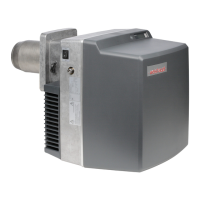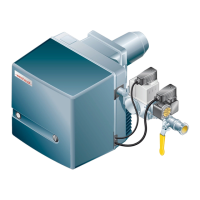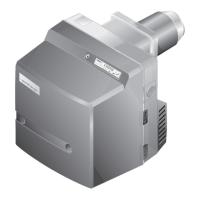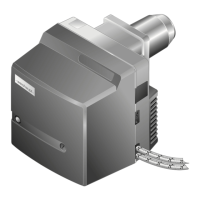37
Combustion analysis
For safe and economic operation of the plant, flue gas
measurements are essential when commissioning.
Example of a simplified calculation for the required
CO
2
value
Given that: CO
2max
= 12%
At CO limit of approx 100ppm: CO
2
measured = 11·5%
CO
2 max.
12
Gives excess air: λ = = = 1·04
CO
2 meas.
11·5
To provide for a safe amount of excess air, increase excess
air by 15%: 1·04 + 0·15 = 1·19
CO
2
value to be set with excess air λ = 1·19 and with CO
2
max potential of 12%.:
CO
2 max.
12
CO
2
==≈ 10·1 %
λ 1·19
The final CO content must not exceed 50 ppm.
Observe flue gas temperature
Flue gas temperature for nominal load (high-fire) is the
result of burner setting at nominal loading.
The flue gas temperature at partial load (low-fire) is the
result of the commissioned control range. The appliance
manufacturer’s instructions must be adhered to in respect
the partial load (low-fire) setting. This might be 50 - 60% of
nominal load setting, or even higher with an air-heater,
whereas a condensing boiler may require the maximum
available turndown within the burner’s capacity range.
Often the partial load (low-firing-rate) is shown on the
appliance’s data plate.
The flue gas installation should also be set out to protect
against damage due to condensation (excluding acid-
proof chimneys).
Determination of flue gas losses
The oxygen content of the undiluted flue gas and the
difference between the flue gas temperature and the
combustion air inlet temperature must be determined. The
oxygen content and the flue gas temperature must be
measured at the same time at one point. Instead of oxygen
content, the carbon dioxide content of the flue gas can
also be measured. The combustion air temperature is
measured in the proximity of the burner air intake.
The flue gas losses are calculated when measuring the
oxygen content according to the equation:
A
2
q
A
=(t
A
- t
L
) • ( +B)
21 – O
2
If the carbon dioxide content is measured instead of the
oxygen content, the calculation is carried out according to
the equation:
A
1
q
A
=(t
A
- t
L
) • ( +B)
CO
2
whereby:
q
A
= flue gas losses in %
t
A
= flue gas temperature in °C
t
L
= combustion air temperature in °C
CO
2
= % of carbon dioxide in dry flue gas
O
2
= % of oxygen in dry flue gas
Natural Liquid Petroleum Gas
Gas and
LPG / Air mix
A
1
= 0·37 0·42
A
2
= 0·66 0·63
B = 0·009 0·08
Calorific values and max. CO
2
(guide values) of various types of gases
Gas type Calorific value H
i
CO
2
max.
MJ/m
3
kWh/m
3
%
1
st
gas family
Group A (Town Gas) 15·12…17·64 4·20…4·90 12…13
Group B (Grid Gas) 15·91…18·83 4·42…5·23 10
2
nd
gas family
Group LL (Natural Gas) 28·48…36·40 7·91…10·11 11·5…11·7
Group E (Natural Gas) 33·91…42·70 9·42…11·86 11·8…12·5
3
rd
gas family
Propane P 93·21 25·99 13·8
Butane B 123·81 34·30 14·1
For the various maximum CO
2
contents contact the gas supplier.

